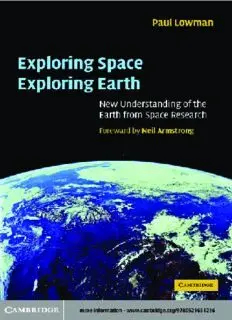Table Of ContentThis page intentionally left blank
Exploring Space, Exploring Earth
Paul Lowman,a NASA scientist for over 40 years,describes the
impact of space flight on geology and geophysics.A foreword by
Neil Armstrong emphasizes that the exploration of space has led
us to a far deeper understanding of our own planet.Direct results
from Earth-orbital missions include studies of Earth’s gravity and
magnetic fields.In contrast,the recognition of the economic and
biological significance of impact craters on Earth is an indirect
consequence of the study of the geology of other planets.The final
chapter presents a new theory for the tectonic evolution of the
Earth based on comparative planetology and the Gaia concept.
Extensive illustrations,a glossary of technical terms,and a
comprehensive bibliography provide geologists and geophysicists
with a valuable summary of research.The book will also serve as a
supplementary text for students of tectonics,remote sensing and
planetary science.
has been involved in a wide range of space
research programs at the Goddard Space Flight Center.In 1963–4
he took part in planning for the Apollo missions.He was Principal
Investigator for Synoptic Terrain Photography on the Mercury,
Gemini,and ApolloEarth-orbital missions,an experiment that laid
the foundation for Landsat.Between 1965 and 1970 he taught
lunar geology at the University of California,Catholic University
of America,and the Air Force Institute of Technology.Dr
Lowman was also involved with the Mariner 9Mars mission,the
ApolloX-ray fluorescence experiment and Apollo 11and 12sample
analysis among others.His main research interest was and still is
the origin of the continental crust,as approached through
comparative planetology.
In 1974,Dr Lowman received the Lindsay Award from the
Goddard Space Flight Center.He was elected a Fellow of the
Geological Society of America in 1975,and of the Geological
Society of Canada in 1988.Drawing on his dual career in
terrestrial and lunar geology,he authored Space Panorama(1968),
Lunar Panorama(1970),and The Third Planet(1972).He also
contributed to Mission to Earth(1976),the first NASA
compilation of Landsatpictures,edited by N.M.Short.
Exploring Space, Exploring Earth
New Understanding of the Earth from
Space Research
Paul D. Lowman Jr.
Goddard Space Flight Center
Foreword by Neil A. Armstrong
Cambridge, New York, Melbourne, Madrid, Cape Town, Singapore, São Paulo
Cambridge University Press
The Edinburgh Building, Cambridge , United Kingdom
Published in the United States by Cambridge University Press, New York
www.cambridge.org
Information on this title: www.cambridge.org/9780521661256
© NASA 2002
This book is in copyright. Subject to statutory exception and to the provision of
relevant collective licensing agreements, no reproduction of any part may take place
without the written permission of Cambridge University Press.
First published in print format 2002
ISBN-13 978-0-511-06648-1 eBook (NetLibrary)
ISBN-10 0-511-06648-1 eBook (NetLibrary)
ISBN-13 978-0-521-66125-6 hardback
ISBN-10 0-521-66125-0 hardback
ISBN-13 978-0-521-89062-5 paperback
ISBN-10 0-521-89062-4 paperback
Cambridge University Press has no responsibility for the persistence or accuracy of
s for external or third-party internet websites referred to in this book, and does not
guarantee that any content on such websites is, or will remain, accurate or appropriate.
Exploring Space, Exploring Earth constitutes a Work of the United States Government
for which no copyright coverage shall exist in the United States 2002
To John A. O’Keefe
Founder of Space Geodesy
CONTENTS
Foreword by Neil A.Armstrong xi
Preface xiii
Acknowledgements xvii
1 Preview of the orbital perspective:
the million-year day 1
1.1 Introduction 1
1.2 A digital tectonic activity map of the Earth 1
1.3 Sea-surface satellite altimetry 5
1.4 Satellite measurement of plate motion and
deformation 7
1.5 Satellite remote sensing 7
1.6 Satellite magnetic surveys 10
1.7 Origin and significance of the digital tectonic
activity map 12
2 Space geodesy 16
2.1 Introduction 16
2.2 Space geodesy methods 17
2.3 Shape of the Earth 33
2.4 Gravity anomalies and global tectonics 37
2.5 Marine gravity and ocean-floor topography 39
2.6 Plate motion and deformation 45
2.7 Plate tectonics and continental drift 51
2.8 GPSmeasurements of crustal deformation 56
2.9 Earth rotation and expansion tectonics 67
2.10 Extraterrestrial gravity fields 71
2.10.1 Gravity field of the Moon 71
2.10.2 Gravity field of Mars 76
2.10.3 Gravity field of Venus 79
2.11 Summary 82
3 Satellite studies of geomagnetism 83
3.1 Introduction 83
3.2 Satellite investigations of the Earth’s magnetic field 91
3.3 The main field 92
3.4 The crustal field 94
3.5 Extraterrestrial magnetic fields 112
3.6 Summary 120
vii
viii CONTENTS
4 Remote sensing: the view from space 123
4.1 Introduction 123
4.2 Orbital remote sensing in geology:a brief history 126
4.3 Tectonics and structural geology 129
4.3.1 Global tectonic activity map 129
4.3.2 Tectonics of southern Asia 131
4.3.3 Elsinore Fault 136
4.3.4 Lineament tectonics 141
4.4 Exploration geology 153
4.4.1 Petroleum exploration 153
4.4.2 Mineral exploration 162
4.5 Environmental geology 167
4.5.1 Active volcanism 167
4.5.2 Glacial geology 178
4.5.3 Aeolian geology and desertification 183
4.6 Summary 190
5 Impact cratering and terrestrial geology 191
5.1 Introduction 191
5.2 Hypervelocity impact 193
5.3 Impact craters 196
5.4 Cratering studies and the space age 203
5.5 Origin of continents 207
5.6 Origin of ocean basins 209
5.7 Economic importance of terrestrial impact
structures 210
5.8 Origin of the Sudbury Structure 214
5.9 Impacts and basaltic magmatism 220
5.10 Impacts and mass extinctions 221
5.11 Summary 223
6 Comparative planetology and the origin of
continental crust 227
6.1 Introduction 227
6.2 Origin of the continental crust 229
6.3 Previous studies 230
6.3.1 Crustal province boundaries:are they sutures? 232
6.3.2 Ensialic greenstone belts 237
6.3.3 Terrane accretion vs.reworking 239
6.4 Thermal histories of planets 242
6.5 Crustal evolution in silicate planets 244
6.5.1 First differentiation 245

